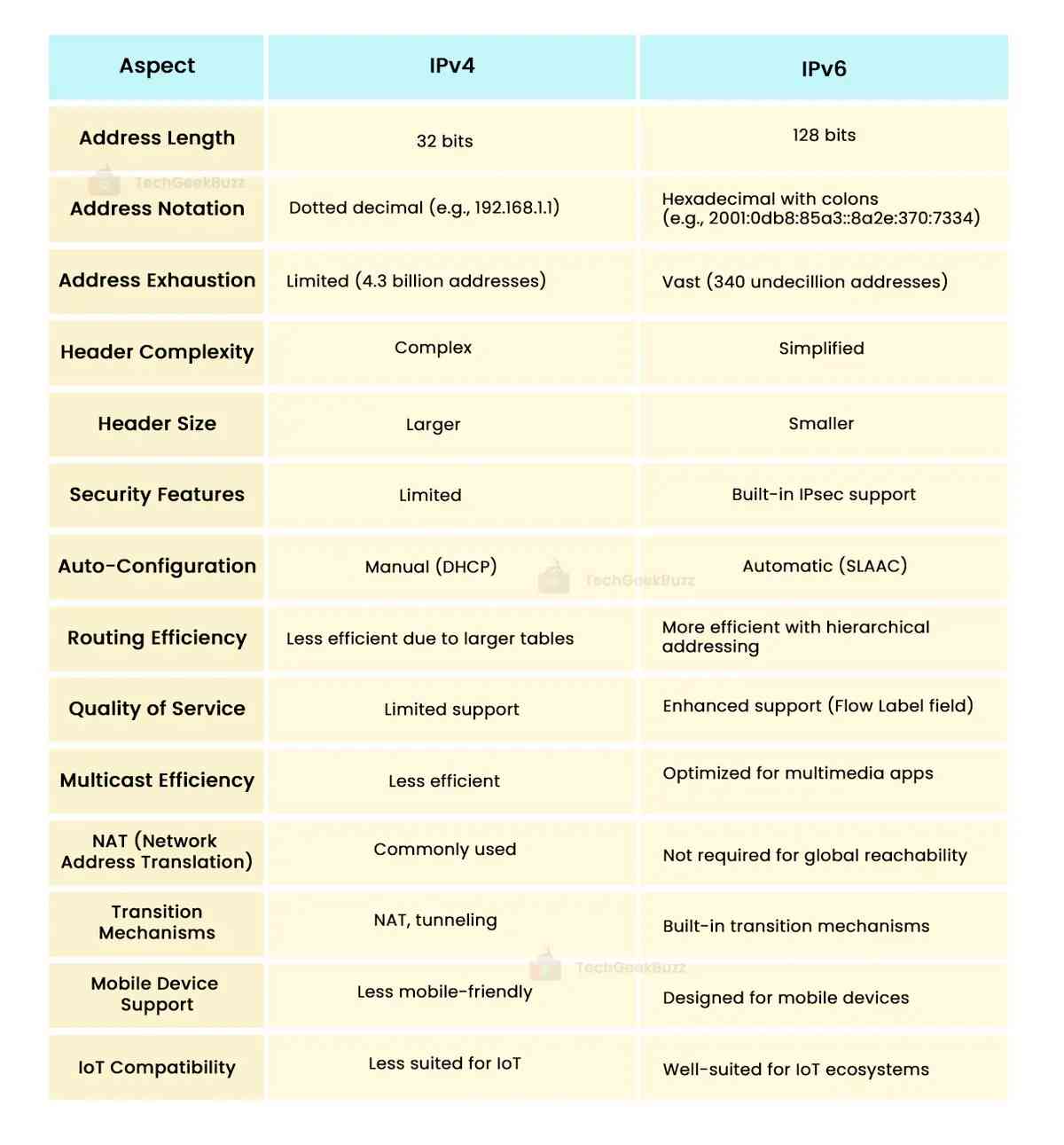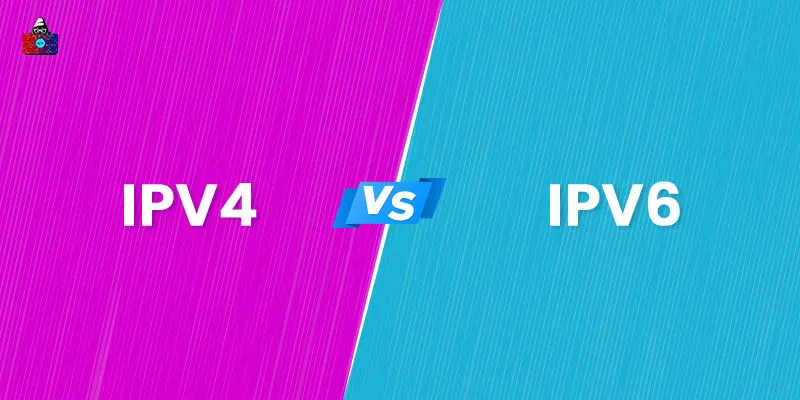As we all have individual house addresses, the same way computers and other devices also do! They are called IP addresses or Internet Protocol addresses. An IP address is a unique numerical address or label assigned to each device in a network.
When it comes to internet protocols, there are two versions - IPv4 and IPv6 - that represent the IP addresses. The primary difference between IPv4 and IPv6 is that the former uses a 32-bit address format, while the latter uses a 128-bit address format.
This article briefly introduces both IP versions - IPv4 vs. IPv6 - and compares them to understand their differences.
Let’s begin!
IPv4 vs IPv6 - A Quick Overview

Understanding Internet Protocol (IP)
IP or Internet protocol is a set of rules that defines communication between a client and the server. It is responsible for routing data packets correctly from the source device to the destination device.
When a specific computer in a network sends data to another, the data is broken down into small chunks called packets. These chunks of data are sent to the destination device, and it receives them in the order they arrive to decode the exact information.
But how do these data packets reach the destination device? This is where the role of an IP address comes into play.
What is an IP Address?

Each device that can access the internet comes with a unique IP address. An IP address is a numeric address unique to each device in a network. It uniquely identifies the destination device among the millions of systems present on a network. This way, it facilitates the communication of computers or devices over a network by delivering data packets from the source to the destination.
If you want to gain more information about it, you can read our article: What is IP Address?
Versions of IP
There are two versions of IP, often referred to as the types.
- IPv4 (Internet Protocol Version 4)
- IPv6 (Internet Protocol Version 6)
IPv4 was the first version of IP with a 32-bit address space. It provided 4.3 billion unique IP addresses. While 4.3 billion sounds too much, the rapid increase in the number of devices accessing the internet has already resulted in the exhaustion of IPv4 addresses.
However, as each internet-enabled device needs to be assigned a unique IP address, there arose the need to switch to the newer IP version, IPv6. It offers many more IP address combinations.
What is IPv4?
IPv4 is the first version of the internet protocol introduced with the advent of the Internet and deployed for the production of the ARPANET in 1983. Though it is the oldest version, many modern devices today still use IPv4. It uses a 32-bit (4 bytes) addressing mode, which means it can allocate 4.3 billion unique addresses.
IPv4 Address Format
IPv4 uses the 32-bit address format. Here is an example:

The addresses in this IP version range from 1 to 255. In the above example, each of the four segments is separated with dots. The device on a network uses the address’s binary format. The numerical format is simply for the host’s reference.
Features of IPv4
- Provides support for about 4.3 billion IP addresses.
- IPv4 uses a 32-bit address.
- Supports the Variable Length Subnet Mask (VLSM).
- Uses Dynamic Host Configuration Protocol (DHCP) to configure the network manually.
- Represents the address in the decimal format.
Advantages of IPv4
- A major portion of internet-enabled devices uses IPv4.
- It is less complex than IPv6.
- IPv4 has security measures to encrypt data in its address packets.
- Most network topologies support IPv4.
- Easy to handle by most systems.
- Guaranteed data delivery.
Disadvantages of IPv4
- Less secure than IPv6.
- Manual configuration via DHCP is complex.
- Inefficient mobility nodes.
- Depletion of public address.
What is IPv6?
IPv6, a newer version of IP, was developed by the Internet Engineering Task Force (IETF) in 1994, and on 14 July 2017, it was ratified as a Draft Standard for the IETF.
This newer version of IP uses a 128-bit address space and can allocate approximately 3.4×(10^38) (340 undecillion, i.e., 340 followed by 36 zeros) unique addresses. IPv6 addresses contain both numbers and letters.
One of the major limitations of both versions is that they are not interoperable. Thus, the direct communication between IPv4 and IPv6 is not possible.
IPv6 Address Format
IPv6 uses a 128-bit IP address format. Here is an example:

The IPv6 address shown above is divided into eight 16-bit blocks. Each block is represented as a hexadecimal number and separated by a colon (:). The total number of addresses in IPv6 is around 340 undecillion.
Features of IPv6
- The most recent version of the Internet protocol.
- Uses a 128-bit address format.
- Provides 3.4×(10^38) (340 undecillion, i.e., 340 followed by 36 zeros) unique addresses.
- Represents an IP address in a hexadecimal form.
Advantages of IPv6
- Modern devices will gradually adopt IPv6.
- Automatic network configuration.
- Offers a large number of IP addresses.
- Virtually unlimited host addresses for each prefix.
- Provides improved support for mobile devices.
Disadvantages of IPv6
- Shifting to IPv6 is a costly affair.
- Harder to fit prefixes on Topology Drawings.
- Long addresses compared to IPv4
IPv4 vs IPv6: Head-to-Head Comparison
Before we move on to discussing the dissimilarities between IPv4 and IPv6, let us first look at the similarities.
Similarities Between IPv4 and IPv6
Despite their differences, both IPv4 and IPv6 share several similarities. Beyond being internet protocols, both:
- Can transmit fragmented packets.
- Used to identify machines connected in a network.
- Have multicasting capabilities along with broadcasting capabilities.
- Provide support for manual IP assignments.
Difference Between IPv4 and IPv6: A Detailed Comparison
The following IPv4 vs. IPv6 table highlights all the key differences between the two based on distinct parameters:
|
Parameters |
IPv4 |
IPv6 |
|
Address Length |
IPv4 uses a 32-bit address format. |
IPv6 uses a 128-bit address format. |
|
Address Representation |
It leverages the decimal format to represent addresses. |
It uses the hexadecimal form to represent addresses. |
|
Address Fields |
IPv4 addresses have 4 fields, separated by a dot (.). |
IPv6 addresses have 8 fields, separated by a colon (:). |
|
Header Field Length |
The length of the IPv4 header field is 20. |
The length of the IPv6 header field is 40. |
|
Address Size |
There are approximately 4.3 billion addresses. |
There are approximately 340 undecillion addresses. |
|
Checksum |
A checksum field is available. |
A checksum field is not available. |
|
Address type |
IPv4 supports unicast, broadcast, and multicast. |
IPv6 supports Unicast, multicast, and anycast. |
|
Virtual Length Subnet Mask |
It supports VLSM. |
It does not support VLSM. |
|
Fragmentation |
Sender and forwarding routes perform fragmentation. |
Only the sender performs fragmentation. |
|
Network Configuration |
In IPv4, we use DHCP to configure the network manually. |
In IPv6, the network is configured automatically. |
|
Security |
IPv4 is less secure, as there is no encryption facility. |
IPv6 employs security measures, such as encryption, to ensure security. |
|
Device Compatibility |
Compatible with all devices but not ideal for mobile devices. |
It is compatible with all devices, including mobile devices. |
|
Address Routing |
IPv4 follows the routing protocol for functioning. |
IPv6 leverages static routes for functioning. |
|
MAC Address Mapping |
It uses the Address Resolution Protocol (ARP) to map MAC addresses. |
IPv6 uses the Neighbour Discovery Protocol (NDP) to map MAC addresses. |
|
IP classes |
IPv4 has 5 types of classes:
|
There are no IP classes in IPv6. |
|
Optional Fields |
It has many optional fields. |
It does not provide an optional field. |
|
Example |
192.116.44.1 |
2001:0000:3238:DFE1:0063:0000:0000:FEFB |
Conclusion
Despite IPv6 being better than IPv4, not all devices have adopted IPv6. This is so because shifting to IPv6 from IPv4 is expensive. For an enterprise to move to IPv6, it has to make a significant investment. However, with time, all devices will shift to IPv6, and there is no doubt that the IPv4 addresses will cease to exist one day.
Hopefully, this article helped you understand all the crucial differences between IPv4 and IPv6. Also, if you have any queries or suggestions, feel free to share them with us in the comments section below.
People are also reading:





Leave a Comment on this Post